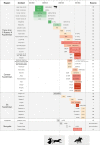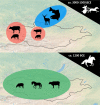Early Pastoral Economies and Herding Transitions in Eastern Eurasia
- PMID: 31969593
- PMCID: PMC6976682
- DOI: 10.1038/s41598-020-57735-y
Early Pastoral Economies and Herding Transitions in Eastern Eurasia
Erratum in
-
Author Correction: Early Pastoral Economies and Herding Transitions in Eastern Eurasia.Sci Rep. 2020 Mar 6;10(1):4536. doi: 10.1038/s41598-020-60516-2. Sci Rep. 2020. PMID: 32139714 Free PMC article.
Abstract
While classic models for the emergence of pastoral groups in Inner Asia describe mounted, horse-borne herders sweeping across the Eurasian Steppes during the Early or Middle Bronze Age (ca. 3000-1500 BCE), the actual economic basis of many early pastoral societies in the region is poorly characterized. In this paper, we use collagen mass fingerprinting and ancient DNA analysis of some of the first stratified and directly dated archaeofaunal assemblages from Mongolia's early pastoral cultures to undertake species identifications of this rare and highly fragmented material. Our results provide evidence for livestock-based, herding subsistence in Mongolia during the late 3rd and early 2nd millennia BCE. We observe no evidence for dietary exploitation of horses prior to the late Bronze Age, ca. 1200 BCE - at which point horses come to dominate ritual assemblages, play a key role in pastoral diets, and greatly influence pastoral mobility. In combination with the broader archaeofaunal record of Inner Asia, our analysis supports models for widespread changes in herding ecology linked to the innovation of horseback riding in Central Asia in the final 2nd millennium BCE. Such a framework can explain key broad-scale patterns in the movement of people, ideas, and material culture in Eurasian prehistory.
Conflict of interest statement
The authors declare no competing interests.
Figures










References
-
- Anthony David, W. The horse, the wheel and language. how Bronze-Age riders from the steppes shaped the modern world. (Princeton University Press, 2007).
-
- Kelekna, P. The horse in human history. (Cambridge University Press Cambridge, 2009).
-
- Gazagnadou, D. The diffusion of a postal relay system in premodern Eurasia. (Editions Kimé, 2016).
-
- Mitchell, P. Horse Nations: The Worldwide Impact of the Horse on Indigenous Societies Post-1492. (OUP, 2015).
Publication types
LinkOut - more resources
Full Text Sources

